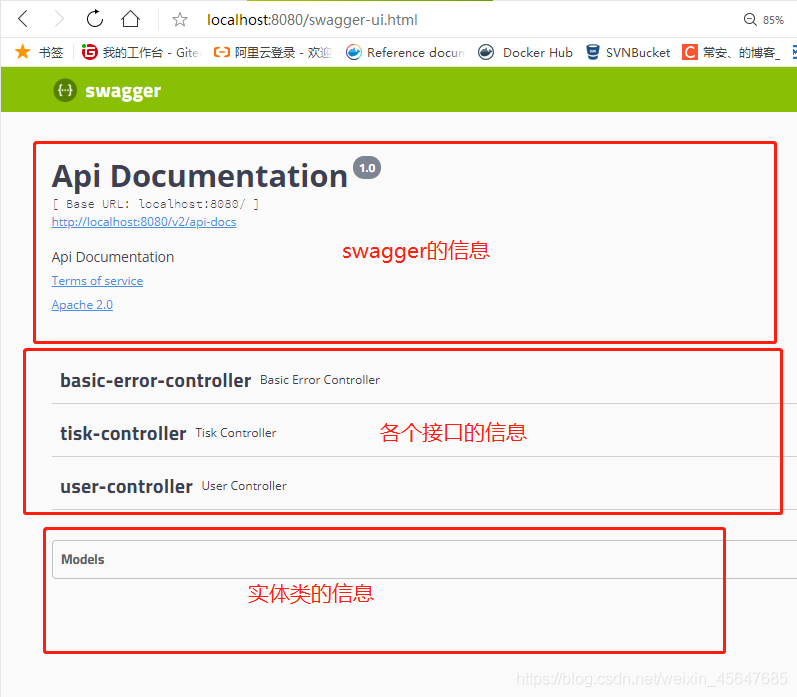溫馨提示×
您好,登錄后才能下訂單哦!
點擊 登錄注冊 即表示同意《億速云用戶服務條款》
您好,登錄后才能下訂單哦!
如何在SpringBoot中對Swagger進行配置?針對這個問題,這篇文章詳細介紹了相對應的分析和解答,希望可以幫助更多想解決這個問題的小伙伴找到更簡單易行的方法。
<!--web方便測試--> <dependency> <groupId>org.springframework.boot</groupId> <artifactId>spring-boot-starter-web</artifactId> </dependency> <!-- swagger2核心包 --> <dependency> <groupId>io.springfox</groupId> <artifactId>springfox-swagger2</artifactId> <version>2.9.2</version> </dependency> <!-- swagger-ui 可視化界面 --> <dependency> <groupId>io.springfox</groupId> <artifactId>springfox-swagger-ui</artifactId> <version>2.9.2</version> </dependency>
Swagger可視化界面可分為三個區域

Swagger相關配置
package com.example.config;
import org.springframework.context.annotation.Bean;
import org.springframework.context.annotation.Configuration;
import springfox.documentation.builders.RequestHandlerSelectors;
import springfox.documentation.service.ApiInfo;
import springfox.documentation.service.Contact;
import springfox.documentation.spi.DocumentationType;
import springfox.documentation.spring.web.plugins.Docket;
import springfox.documentation.swagger2.annotations.EnableSwagger2;
import java.util.ArrayList;
@Configuration
@EnableSwagger2 //開啟Swagger的使用
public class SwaggerConfig {
@Bean //Swagger的使用主要是要將docket對象傳入IOC容器
public Docket docket(){
return new Docket(DocumentationType.SWAGGER_2)
.apiInfo(apiInfo()) //關于文檔的各種信息
.enable(true) //使Swagger生效
.groupName("常安祖")
.select()//選擇掃描的接口
.apis(RequestHandlerSelectors.basePackage("com.example.controller"))//指定掃描的接口
.build();
}
public ApiInfo apiInfo(){
Contact contact = new Contact("長安","https://blog.csdn.net/weixin_45647685","719801748@qq.com");//個人的聯系方式
return new ApiInfo("長安的文檔", "長安的開發文檔", "1.0", "urn:tos",null, "Apache 2.0", "http://www.apache.org/licenses/LICENSE-2.0", new ArrayList());//文檔的各種信息
}
}@ApiModel( ) //主要用來標注返回的實體類
@ApiModelProperty( ) //主要用來標注實體類中的屬性
案例:
@ApiModel("用戶的實體類")
public class User implements Serializable {
@ApiModelProperty("用戶的id")
private Integer id;
@ApiModelProperty("用戶的姓名")
private String name;
@ApiModelProperty("用戶的年紀")
private Integer age;
public Integer getId() {
return id;
}
public User(Integer id, String name, Integer age) {
this.id = id;
this.name = name;
this.age = age;
}
public void setId(Integer id) {
this.id = id;
}
public String getName() {
return name;
}
public void setName(String name) {
this.name = name;
}
public Integer getAge() {
return age;
}
public void setAge(Integer age) {
this.age = age;
}
}@ApiModelProperty用來標注API接口
案例:
package com.yangzihao.controller;
import com.yangzihao.entity.User;
import io.swagger.annotations.ApiModelProperty;
import org.springframework.stereotype.Controller;
import org.springframework.web.bind.annotation.GetMapping;
import org.springframework.web.bind.annotation.RequestMapping;
@RestController
public class UserController {
@ApiModelProperty("得到一個User")
@GetMapping("/getUser")
public User getUser(){
return new User(1,"測試",18);
}
}關于如何在SpringBoot中對Swagger進行配置問題的解答就分享到這里了,希望以上內容可以對大家有一定的幫助,如果你還有很多疑惑沒有解開,可以關注億速云行業資訊頻道了解更多相關知識。
免責聲明:本站發布的內容(圖片、視頻和文字)以原創、轉載和分享為主,文章觀點不代表本網站立場,如果涉及侵權請聯系站長郵箱:is@yisu.com進行舉報,并提供相關證據,一經查實,將立刻刪除涉嫌侵權內容。